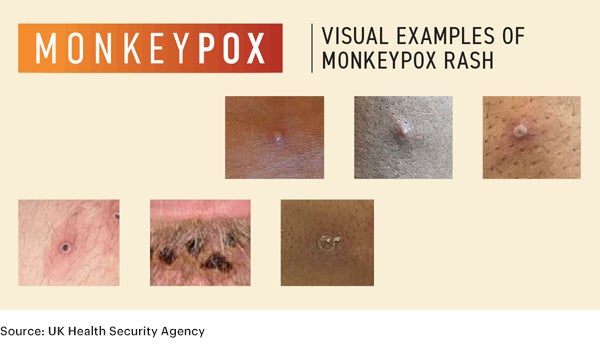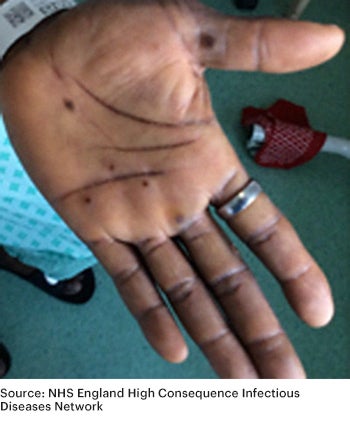Mpox
About mpox
Mpox (previously known as monkeypox) is a rare disease caused by infection with the mpox virus. Mpox virus is part of the same family of viruses as the variola virus, the virus that causes smallpox. Mpox symptoms are similar to smallpox symptoms, but milder, and mpox is rarely fatal. Mpox is not related to chickenpox.
Mpox was discovered in 1958 when two outbreaks of a pox-like disease occurred in colonies of monkeys kept for research. Despite being named monkeypox at that time, the source of the disease remains unknown. However, African rodents and non-human primates (like monkeys) might harbor the virus and infect people.
The first human case of mpox was recorded in 1970. Prior to the 2022 outbreak, mpox had been reported in people in several central and western African countries. Previously, almost all mpox cases in people outside of Africa were linked to international travel to countries where the disease commonly occurs or through imported animals. These cases occurred on multiple continents.
Symptoms
Signs and symptoms
People with mpox get a rash that may be located on or near the genitals (penis, testicles, labia, and vagina) or anus (butthole) and can also appear on other areas like the hands, feet, chest, face, or mouth.
- The rash will go through several stages, including scabs, before healing
- The rash can initially look like pimples or blisters and may be painful or itchy

Other symptoms of mpox can include:
- Fever
- Chills
- Swollen lymph nodes
- Exhaustion
- Muscle aches and backache
- Headache
- Respiratory symptoms (e.g. sore throat, nasal congestion, or cough)
You may experience all or only a few symptoms
- Sometimes, people have flu-like symptoms before the rash
- Some people get a rash first, followed by other symptoms
- Others only experience a rash
How long do mpox symptoms last?
- Mpox symptoms usually start within 3 weeks of exposure to the virus. If someone has flu-like symptoms, they will usually develop a rash 1-4 days later
- Mpox can be spread from the time symptoms start until the rash has healed, all scabs have fallen off, and a fresh layer of skin has formed. The illness typically lasts 2-4 weeks
If you have a new or unexplained rash or other symptoms:
- Avoid close contact, including sex or being intimate with anyone, until you have been checked out by a healthcare provider
- If you don’t have a provider or health insurance, visit a public health clinic near you
- When you see a healthcare provider, wear a mask, and remind them that this virus is circulating in the area
Causes
The exact cause of mpox is uncertain, however, there is evidence to show how it can be spread.
Close contact
Mpox can spread to anyone through close, personal, often skin-to-skin contact, including:
- Direct contact with mpox rash, scabs, or body fluids from a person with mpox
- Touching objects, fabrics (clothing, bedding, or towels), and surfaces that have been used by someone with mpox
- Contact with respiratory secretions
Intimate contact
This direct contact can happen during intimate contact, including:
- Oral, anal, and vaginal sex or touching the genitals (penis, testicles, labia, and vagina) or anus (butthole) of a person with mpox
- Hugging, massage, and kissing
- Prolonged face-to-face contact
- Touching fabrics and objects during sex that were used by a person with mpox and that have not been disinfected, such as bedding, towels, fetish gear, and sex toys
Mpox and pregnancy
A pregnant person can spread the virus to their fetus through the placenta.
Infected animals
It’s also possible for people to get mpox from infected animals, either by being scratched or bitten by the animal or by preparing or eating meat or using products from an infected animal. A person with mpox can spread it to others from the time symptoms start until the rash has fully healed and a fresh layer of skin has formed. The illness typically lasts 2–4 weeks.
Scientists are still researching:
- If the virus can be spread when someone has no symptoms
- How often mpox is spread through respiratory secretions, or when a person with mpox symptoms might be more likely to spread the virus through respiratory secretions.
- Whether mpox can be spread through semen, vaginal fluids, urine, or feces.

Diagnosis
How to know if you have mpox
If you think you may have mpox, you should see your healthcare professional to confirm your diagnosis. Healthcare professionals typically look at your skin to make a diagnosis. Some of the key characteristics include:
- Lesions are firm or rubbery, well-rounded, and often develop what looks like a dot on the top of the lesion.
- During the current global outbreak:
- Lesions often occur in the genital and anorectal areas or in the mouth
- Rash is not always disseminated across many sites on the body
- Rash may be confined to only a few lesions or only a single lesion
- Rash does not always appear on palms and soles
- Rectal symptoms (eg, bloody stools, rectal pain, or rectal bleeding) have been frequently reported in the current outbreak
- Lesions are often described as painful until the healing phase when they become itchy (crusts)
- Fever and other prodromal symptoms (e.g., chills, lymphadenopathy, malaise, myalgias, or headache) can occur before rash but may occur after rash or not be present at all
- Respiratory symptoms (e.g. sore throat, nasal congestion, or cough) can occur
Lesions typically develop simultaneously and the incubation period is 3-17 days. During this time, a person does not have symptoms and may feel fine. The full term for this illness is typically 2-to-4 weeks.
Treatment
There are no treatments specifically for mpox virus infections. However, mpox and smallpox viruses are genetically similar, which means that antiviral drugs and vaccines developed to protect against smallpox may be used to prevent and treat mpox virus infections.
FAQs
You have questions and we have answers from Joseph Vassolotti, MD, the Chief Medical Officer for the National Kidney Foundation
This content is provided for informational use only and is not intended as medical advice or as a substitute for the medical advice of a healthcare professional.
